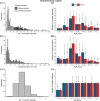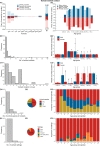Patterns of human social contact and contact with animals in Shanghai, China
- PMID: 31641189
- PMCID: PMC6805924
- DOI: 10.1038/s41598-019-51609-8
Patterns of human social contact and contact with animals in Shanghai, China
Abstract
East Asia is as a principal hotspot for emerging zoonotic infections. Understanding the likely pathways for their emergence and spread requires knowledge on human-human and human-animal contacts, but such studies are rare. We used self-completed and interviewer-completed contact diaries to quantify patterns of these contacts for 965 individuals in 2017/2018 in a high-income densely-populated area of China, Shanghai City. Interviewer-completed diaries recorded more social contacts (19.3 vs. 18.0) and longer social contact duration (35.0 vs. 29.1 hours) than self-reporting. Strong age-assortativity was observed in all age groups especially among young participants (aged 7-20) and middle aged participants (25-55 years). 17.7% of participants reported touching animals (15.3% (pets), 0.0% (poultry) and 0.1% (livestock)). Human-human contact was very frequent but contact with animals (especially poultry) was rare although associated with frequent human-human contact. Hence, this densely populated area is more likely to act as an accelerator for human-human spread but less likely to be at the source of a zoonosis outbreak. We also propose that telephone interview at the end of reporting day is a potential improvement of the design of future contact surveys.
Conflict of interest statement
H.Y. has received investigator-initiated research funding from Sanofi Pasteur, GlaxoSmithKline, and Yichang HEC Changjiang Pharmaceutical Company. Other authors have declared that no competing interests exist.
Figures





Similar articles
-
Animal Ownership and Touching Enrich the Context of Social Contacts Relevant to the Spread of Human Infectious Diseases.PLoS One. 2015 Jul 20;10(7):e0133461. doi: 10.1371/journal.pone.0133461. eCollection 2015. PLoS One. 2015. PMID: 26193480 Free PMC article.
-
Social contact patterns relevant to the spread of respiratory infectious diseases in Hong Kong.Sci Rep. 2017 Aug 11;7(1):7974. doi: 10.1038/s41598-017-08241-1. Sci Rep. 2017. PMID: 28801623 Free PMC article.
-
Representative contact diaries for modeling the spread of infectious diseases in Taiwan.PLoS One. 2012;7(10):e45113. doi: 10.1371/journal.pone.0045113. Epub 2012 Oct 3. PLoS One. 2012. PMID: 23056193 Free PMC article.
-
Mining social mixing patterns for infectious disease models based on a two-day population survey in Belgium.BMC Infect Dis. 2009 Jan 20;9:5. doi: 10.1186/1471-2334-9-5. BMC Infect Dis. 2009. PMID: 19154612 Free PMC article.
-
Spatiotemporal heterogeneity of social contact patterns related to infectious diseases in the Guangdong Province, China.Sci Rep. 2020 Apr 15;10(1):6119. doi: 10.1038/s41598-020-63383-z. Sci Rep. 2020. PMID: 32296083 Free PMC article.
Cited by
-
SOCRATES: an online tool leveraging a social contact data sharing initiative to assess mitigation strategies for COVID-19.BMC Res Notes. 2020 Jun 16;13(1):293. doi: 10.1186/s13104-020-05136-9. BMC Res Notes. 2020. PMID: 32546245 Free PMC article.
-
Patterns of human social contact and mask wearing in high-risk groups in China.Infect Dis Poverty. 2022 Jun 18;11(1):69. doi: 10.1186/s40249-022-00988-8. Infect Dis Poverty. 2022. PMID: 35717198 Free PMC article.
-
Optimize data-driven multi-agent simulation for COVID-19 transmission.BMC Bioinformatics. 2022 Jul 1;23(1):260. doi: 10.1186/s12859-022-04799-4. BMC Bioinformatics. 2022. PMID: 35778688 Free PMC article.
-
Social contacts patterns relevant to the transmission of infectious diseases in Suzhou, China following the COVID-19 epidemic.J Health Popul Nutr. 2024 May 9;43(1):58. doi: 10.1186/s41043-024-00555-x. J Health Popul Nutr. 2024. PMID: 38725055 Free PMC article.
-
Social contact patterns and implications for infectious disease transmission - a systematic review and meta-analysis of contact surveys.Elife. 2021 Nov 25;10:e70294. doi: 10.7554/eLife.70294. Elife. 2021. PMID: 34821551 Free PMC article.
References
-
- Pourbohloul, B. Modeling infectious diseases in humans and animals. (Princeton University Press, 2008).
Publication types
MeSH terms
Grants and funding
LinkOut - more resources
Full Text Sources

